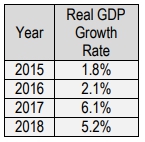Alright. Now, let's discuss growth rates a little more and how we analyze them as well as the rule of 70. So, there are several important calculations we're going to talk about here, and when we talk about economic growth, we're generally talking about growth in GDP. We're focused on the growth in GDP, and we're going to use a few different calculations we can use when we talk about what that growth is. The first one is just what is the annual growth rate? And this is basically just a simple percentage change calculation. A percentage change calculation where we take the annual growth rate being the current GDP minus the prior year's GDP, divided by the prior year's GDP, and remember, whenever we talk about percentage change, we talk about that new minus old divided by old and that's exactly what's going on here. The growth rate is going to be current GDP minus old GDP divided by old GDP. That'll give us the percentage change. Okay? So that's our annual growth rate.
We can also talk about an average annual growth rate. We've got growth rates for every year, maybe 2 years ago it was 2% and now it's 4% and then 5%, right? How do we find the average annual growth? Well, guess what? That's just like finding an average. To find your average in a class, you would add up all your grades on the exam divided by how many exams you took assuming they are all weighted the same, right? And we would find out the average. So what we're going to do is we're going to take all the growth rates. Let's say there was growth rate 1 this year, growth rate 2 in the next year until the final year, and then you'll divide it by the number of years, right? The number of years that you added growth rates for. So it's just a simple average calculation, and that will give you the average annual growth, right? Because maybe some years you have a lot of growth, some years you have a little, maybe 1 year you didn't grow at all. Well, we'll find the average of all those years together with that formula. Just add up all the growths and divide by the number, right? That's just a simple average formula there.
Finally, the rule of 70. They love to talk about this rule of 70 because it talks about how long it would take for a value to double. So how long will it take for GDP to double if this year GDP is $1,000,000,000? How long will it take for GDP to be $2,000,000,000? Well, that depends on the growth rate. So, with the rule of 70, it gives us an approximation of how long it is going to take to double and all we have to do with the rule of 70, the number of years to double is 70 divided by the growth rate. A lot of times, this will be the average growth rate. Generally, we'll talk about the average growth rate here. And when you do this calculation, the growth rate should be put in as a whole number. So 2% would be 2. We wouldn't put it as 0.02, okay? So that's the little trick here is that we put 2% as 2, not 0.02; that would give us a crazy number. So let's go ahead and do a little bit of practice here with the rule of 70 and then you guys can try as well. Let's do this first example.
Use the rule of 70 to analyze the following growth rates. Let's go ahead and see what happens. If the growth rate is 2%, 4%, or 6%. So in which case do you think we would have the fastest time till double? Which one is going to double the quickest? 6%, right? Because we're growing faster. If we're growing 6% every year, we would assume that we would double faster. Okay. So let me open up my calculator and let's do these calculations.
How long would it take us to double at a growth of 2%? What we would do is 70 divided by 2. The percentage there, 2 and that gives us approximately 35 years. How about when it's 4%? 70 divided by 4. So 70 divided by 4, that's going to give us 17.5 years. Now what about when it's 6%, 70 divided by 6. 70/6=11.67 years to double, right? So this is telling us how long it would take to double.
So, what do we have here? So notice that small differences. The point here is that small differences in growth rates can have large impacts on the standard of living in a country, right? So notice when it's just at 2%, it's going to take us 35 years to double. But just by going from 2% to 4%, even though that's double the amount but 4%, that still doesn't sound like that much growth, right? It means that the economy is going to double in 17.5 years, it's going to double twice as fast there, and then 6%, 17.67 years. So these small changes, these small percentage changes are having huge impacts in the long run of how long the economy is going to take to double there, okay? So that's the key here is that even small changes in economic growth can lead to large differences. Cool? Alright. Let's pause here and do this example in the next video.


